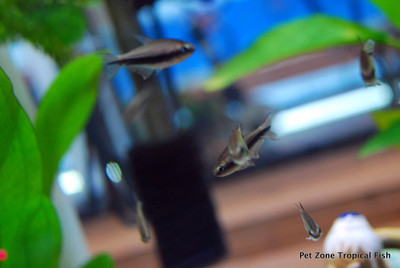Emperor Tetra: The Majestic Ruler of Aquatic Realms
Posted by Max Gandara on on 13th Jul 2023
In the vibrant realm of freshwater aquariums, the Emperor Tetra
(Nematobrycon palmeri) stands out as a regal presence. With its
captivating beauty, striking coloration, and peaceful nature, this
tropical fish species has earned its place as a beloved inhabitant of
many aquarists' tanks. In this article, we will delve into the world of
the Emperor Tetra, exploring its origins, characteristics, care
requirements, and the joys it brings to aquatic enthusiasts.
The Emperor Tetra, also known as the Emperor Blue Tetra, hails from the
intricate waterways of South America. Native to the river basins of
Colombia and western Venezuela, this species thrives in slow-moving or
stagnant waters. It primarily inhabits blackwater environments, where
decomposing leaves tint the water with a tea-like color, mimicking its
natural habitat.
The Emperor Tetra is renowned for its stunning appearance. It features
an elongated, streamlined body with a deeply forked tail fin that aids
in swift and graceful swimming. The coloration of this species is truly
captivating. Its body is adorned with a vibrant iridescent blue hue,
which transitions into a fiery red towards the tail. A vertical black
band extends across its eye, contrasting beautifully with the overall
color palette. Mature males often exhibit longer and more elaborate
fins, enhancing their visual appeal.
Unlike some other aggressive tetra species, the Emperor Tetra is known
for its peaceful nature. It is an excellent choice for community
aquariums, coexisting peacefully with other peaceful species of similar
size. Being a schooling fish, Emperor Tetras thrive in groups of six or
more, where they feel secure and exhibit their natural behaviors. They
spend most of their time swimming in the middle and upper levels of the
water column, adding liveliness and elegance to the aquarium.
Providing a suitable habitat is essential for the well-being of Emperor
Tetras. A spacious aquarium of at least 20 gallons is recommended to
accommodate a small group. The tank should be well-established, ideally
with live plants and plenty of hiding spots created using driftwood,
rocks, or dense vegetation. These elements simulate their natural
environment and offer shelter. Additionally, dimmed lighting and a dark
substrate can help replicate the blackwater conditions they prefer.
Water parameters should be carefully monitored. Emperor Tetras thrive in
soft, acidic water with a pH ranging from 5.5 to 7.0. The temperature
should be maintained between 74°F and 82°F (23°C to 28°C). Regular water
changes are crucial to maintain water quality and provide a healthy
environment for these delicate creatures.
Emperor Tetras are omnivorous, feeding on a variety of foods in the
wild. In captivity, they readily accept a well-balanced diet comprising
high-quality flake or pellet food, supplemented with live or frozen
foods like brine shrimp, daphnia, or bloodworms. Offering a diverse diet
helps ensure their nutritional needs are met and promotes vibrant
coloration.
Breeding Emperor Tetras can be a rewarding experience. To encourage
spawning, a separate breeding tank with fine-leaved plants, such as Java
moss, is recommended. The water should be slightly acidic and soft.
Conditioning the fish with nutritious live or frozen foods can stimulate
the breeding process.
Once the female lays the eggs among the plants, the parents should be
removed to prevent them from consuming the eggs. The eggs typically
hatch within 24-36 hours, and the fry can be fed infusoria or
specialized fry foods until they are large enough to accept other small
foods.
The Emperor Tetra, with its captivating beauty and serene demeanor,
holds a special place in the hearts of freshwater aquarium enthusiasts.
Its striking appearance, peaceful nature, and ease of care make it an
ideal choice for both beginner and experienced aquarists. By providing
the Emperor Tetra with a suitable environment and proper care, aquarists
can admire and appreciate the regal elegance this species brings to
their aquatic realms.

